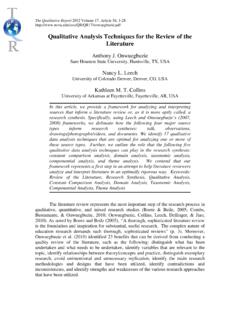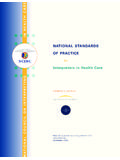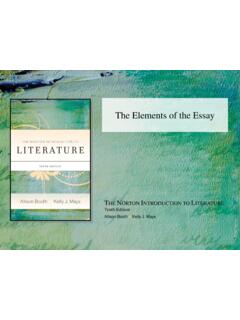Transcription of Mapping Saldaňa’s Coding Methods onto the Literature ...
1 Journal of Educational Issues ISSN 2377-2263 2016, Vol. 2, No. 1 130 Mapping Salda a s Coding Methods onto the Literature Review Process Anthony J. Onwuegbuzie (Corresponding author) Department of Educational Leadership and Counseling, Box 2119 Sam Houston State University, Huntsville, Texas 77341-2119, USA Tel: 1-936-294-4509 E-mail: Rebecca K. Frels Department of Counseling and Special Populations Lamar University, 223 Education Building, Beaumont, Texas 77710, USA E-mail: Eunjin Hwang Department of Educational Leadership and Counseling, Box 2119 Sam Houston State University, Huntsville, Texas 77341-2119, USA E-mail: Received: January 24, 2016 Accepted: March 28, 2016 Published: March 29, 2016 URL: Abstract Onwuegbuzie and Frels (2014) provided a step-by-step guide illustrating how discourse analysis can be used to analyze Literature .
2 However, more works of this type are needed to address the way that counselor researchers conduct Literature reviews. Therefore, we present a typology for Coding and analyzing information extracted for Literature reviews based on Salda a s (2012) Coding Methods . We present stages for conducting these analyses using an actual body of published works and illustrate how to use a computer-assisted qualitative data analysis software program, namely, QDA Miner. Finally, we delineate how using this systematic approach promotes counselor identity and addresses the call for ethical, transparent research and evidence-based practices.
3 Journal of Educational Issues ISSN 2377-2263 2016, Vol. 2, No. 1 131 Keywords: Literature review, Salda a s Coding Methods , analyzing the Literature , Coding the Literature , Computer-assisted qualitative data analysis software program, QDA Miner 1. Introduction The promotion of evidence-based practice and outcome research has moved to the foreground in the ongoing dialogue of the counseling profession. Evidenced-based practice is dependent upon rigorous and transparent methodology outlined in the manifestoes of professional organizations such as the American Counseling Association s (2014) Code of Ethics, the American Evaluation Association s (2004) Guiding Principles, and the Council for Accreditation of Counseling and Related Education Program s (2016) Standards.
4 Research builds upon and expands the knowledge of a practice or topic and, without fail, is based upon prior research. Yet, conducting the Literature review represents the most difficult component of the research process and is seldom discussed within the scope of methodology and ethical reporting standards. Regardless of research methodology ( , quantitative, qualitative, mixed Methods ), at some point, the research is linked to prior Literature . Interestingly, when considering how long the practice of Literature reviewing has been part of scholarship, it is surprising that reporting standards do not better affirm the importance of a systematic process for delineating and building upon prior research.
5 The American Psychological Association (APA) Publication Manual (2010) situates the concept of Literature review as a critical evaluation(s) of material that has already been published (p. 10) and reveals that authors of Literature reviews organize, integrate, and evaluate the state of research. To this end, when the goal of the Literature review is to inform primary research, then the Literature reviewer should conduct a series of Literature reviews, as needed, throughout the conduct of the primary research (Onwuegbuzie & Frels, 2014). Indeed, as outlined by Onwuegbuzie and Frels (2016), the review of the Literature can inform any or all of the 12 components of a primary research report: problem statement, Literature review, theoretical/conceptual framework research question(s), hypotheses, participants, instruments, procedures, analyses, interpretation of the findings, directions for future research, and implications for the field.
6 Simply put, a difficulty for many Literature reviewers is to recognize that the Literature review process does not end at the onset of the primary study. That is, the Literature review typically should take place throughout the research process before, during, and after the primary research study (Onwuegbuzie & Frels, 2016). As such, with very few exceptions ( , grounded theory research (Glaser & Strauss, 1967), wherein some proponents argue against an initial Literature review before data collection), the Literature review can be the most intense and time-consuming component of the research process, especially when the extant Literature for the underlying topic is extensive.
7 A second difficulty of the Literature review process stems from the fact that it is not a linear process (Onwuegbuzie & Frels, 2016). Even though the Literature review typically precedes the primary research study in most instances, it is very common for research to oscillate between the primary research study and the extant information. This non-linearity adds complexity to the Literature review process. A third difficulty is that Literature reviews cannot be value neutral (Onwuegbuzie & Frels, Journal of Educational Issues ISSN 2377-2263 2016, Vol.)
8 2, No. 1 1322012). Indeed, in every case, Literature reviewers make a series of decisions such as what sources are used to inform the Literature review, what Literature is included and excluded, what Literature is emphasized or criticized, and so on. As such, any given Literature review can be framed in numerous ways that reflect the value system of the Literature reviewer. With the valuable resources available via the Internet, a common misconception is that Literature reviewers fail to recognize that salient information on a topic reaches beyond published works (Onwuegbuzie & Frels, 2016).
9 Valuable information that informs Literature reviews often can be gleaned from unpublished works. One example of such unpublished works is grey Literature (or gray Literature ). Grey Literature includes the following: reports ( , pre-prints, preliminary progress and advanced reports, technical reports from government agencies or scientific research groups, statistical reports, memoranda, market research reports, state-of-the art reports, working papers from research groups or committees white paper), conference proceedings, technical reports, technical specifications and standards, bibliographies, non-commercial translations, technical and commercial documentation, and official documents that have not published commercially such as government reports and documents (Alberani, Pietrangeli, & Mazza, 1990).
10 As noted by Augur (1989), grey Literature often is generated by organizations such as associations, county councils, churches, federations, institutes, laboratories, libraries, museums, private publishers, research facilities, societies, trade unions, universities, and other educational establishments. As such, for any given topic of interest, the Literature review process can be extended greatly by reviewing grey Literature . For example, in the field of counseling, preliminary research findings and cutting-edge findings are presented at the annual conferences for the Association of Counselor Education and Supervision, the American Counseling Association, and other established venues.

















